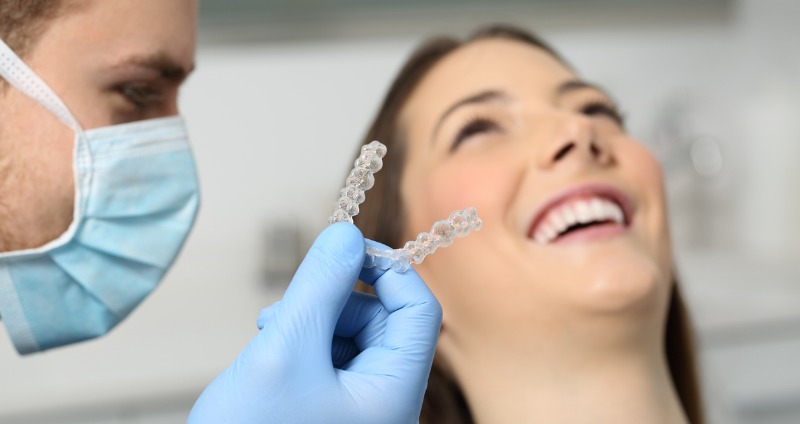
Invisalign has been a game changer for orthodontics. The clear plastic aligner system has appealed to over five million orthodontic patients around the world. Better aesthetics are the most appealing part of the revolutionary treatment method, but looks shouldn’t be the only thing to consider when looking at getting orthodontic treatment. To fix some problems, other treatments such as braces could be more suitable which is why it’s essential to get expert, personalised advice from an Orthodontist.
Which Orthodontic Issues Can Invisalign Treat?
The following issues can be treated by Invisalign in some patients, but not all, depending on the severity or if there are a combination of issues:
Crooked Teeth
If you are looking to straighten your smile, Invisalign is an option.
Overbite
An overbite (when the upper teeth close too far in front of the bottom teeth) can make it difficult to chew and bite into some foods.
Can Invisalign fix overbite? Yes, in some cases Invisalign can be used to move teeth so that the top and bottom teeth align properly when your mouth is closed.
Underbite
An underbite (when bottom teeth are in front of upper teeth) can cause your teeth to wear more quickly and create difficulties with speech.
Can Invisalign treat an underbite? Yes, Invisalign can be used to move the lower teeth back so they naturally sit behind the front teeth.
In extreme cases, braces may be combined with Invisalign and some underbite cases can’t be treated with Invisalign.
Crossbite
A crossbite (when some upper teeth sit inside lower teeth rather than outside ) can cause your teeth to chip and wear down and even cause gums to recede.
You might be wondering if Invisalign can fix crossbite? In many cases Invisalign can be used to move incorrectly positioned teeth into the right place and treat a crossbite.
Gaps in Teeth
If you have a gap between two or more teeth, you have a spacing issue. This excess space is a problem with food getting caught between teeth and gums, causing pain and gum disease. Invisalign can close the gaps to create a healthier mouth and more aesthetic smile but there are limitations in how much space needs to be closed.
Open Bite
Invisalign can fix an open bite (when upper and lower teeth don’t meet) by moving upper and lower teeth into position so they close correctly.
Crowded Teeth
When there is not enough room in the jaw to accommodate all of your teeth, they can overlap and twist, this is known as crowding. The reduced space between teeth allows for food to become stuck and for tartar and plaque to build up which may contribute to tooth decay and gum disease.
Can invisalign fix crowding? Invisalign can work for some cases of crowded teeth, depending on the severity and complexity of the problem.

Limitations of Invisalign
Invisalign doesn’t have the same force and capabilities to move teeth as braces. Therefore, complex orthodontic treatment or cases that require significant movement of teeth need braces, not Invisalign to achieve the desired outcome.
Below are some situations where Invisalign may not work as effectively as braces:
Tooth Shape
Some patients have teeth that aren’t ideal for fitting inside the aligner. Short, round, pegged teeth or those with severe tips may not allow the aligner to get a good grip. Therefore, the aligner isn’t effective at moving your teeth into the desired position.
Tooth Position
When a mouth is overcrowded, a tooth may rotate to fit. If the rotation is over 20 degrees for molars, Invisalign is unable to move them into the desired position. The degree of rotation can be more if the rotated teeth are canines, premolars and incisors.
Teeth can also tilt forward or back to fit in a crowded mouth. If the tilt is over 45 degrees, Invisalign will struggle to pull the tooth up into the right place.
Large Gaps Between Teeth
Whether there is just one gap between two teeth or several gaps a patient would like closed, Invisalign can only reliably close up to 6mm of space per arch (top teeth or lower teeth).
Intrusion and Extrusion
Orthodontics can raise and lower the position of teeth in the jawbone so the height of the teeth is the same. Braces have the force to move teeth into position while Invisalign can only achieve limited movement in front teeth and almost no movement in back teeth.
Midline Movements
Some patients have front teeth that don’t match their midline (the imaginary line down the middle of the face). Invisalign can correct a midline discrepancy by 2mm to the left or right per arch but anything larger needs to be treated with braces.
Previous Dental Work
Some prior dental work can preclude patients from using Invisalign. A dental bridge can make it impossible for using Invisalign. A patient with porcelain veneers or crowns may not be able to use attachments with their Invisalign because they can’t bond to the surface.
Want to Straighten Your Teeth Without Braces?
Invisalign® uses innovative technology to straighten your teeth without wires or brackets! Improve your smile and book an appointment!
New Dental Work
If a patient has dental work such as a crown or porcelain veneers after Invisalign retainers have been made, they may not fit properly or they won’t be effective in manipulating teeth into place. An orthodontist will check any previous dental treatment to ensure Invisalign is suitable before proceeding.
Once aligners have been made, all dental restoration work must wait until after Invisalign treatment has been completed. Even work on just one tooth can cause aligners to no longer work.
Extractions are Required
Invisalign aren’t suitable for patients requiring extractions before or during treatment.
Use of Visible Attachments
Invisalign patients often choose this treatment because the aligners are virtually invisible. However, some Invisalign patients need to use attachments with their Invisalign. The enamel coloured, button like attachments are slightly visible.
Orthodontic Treatment and Technology is Changing All the Time
With technology improvements and orthodontists’ developing their experience in using Invisalign, the limitations are reducing all the time. More complex cases are now being successfully treated with Invisalign when compared to a few years ago.
If you have any questions about whether Invisalign is suitable for you, make an obligation free appointment with The Orthodontists by calling (08) 9364 8020 or contact us online.